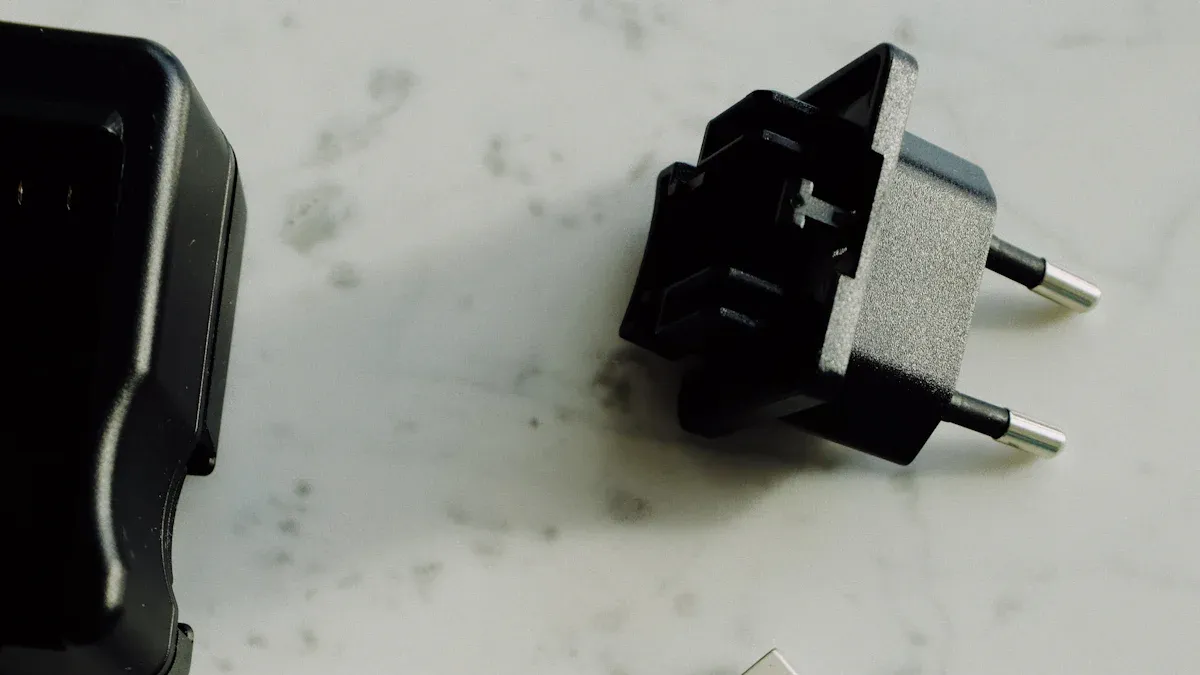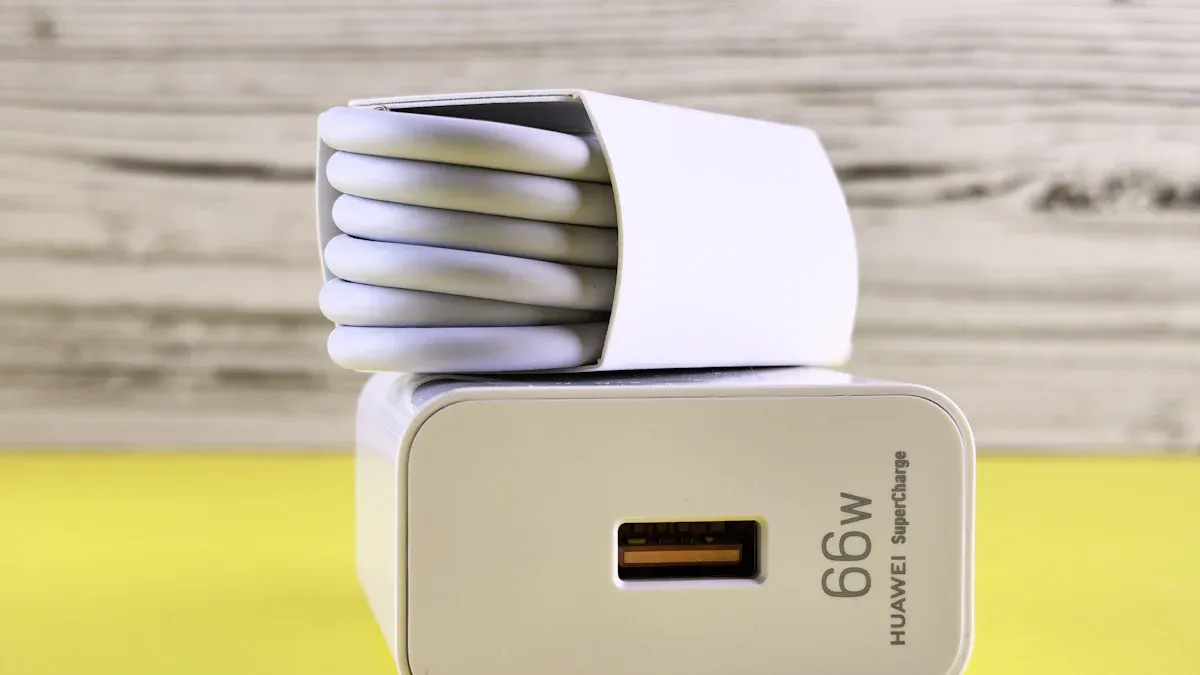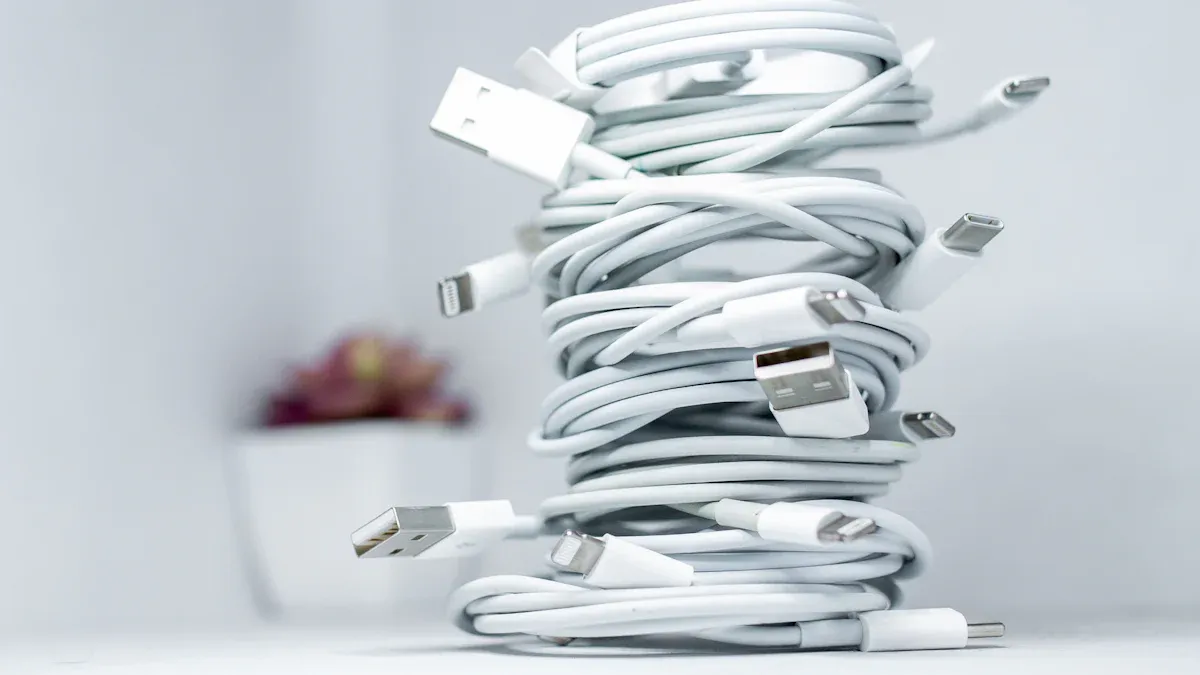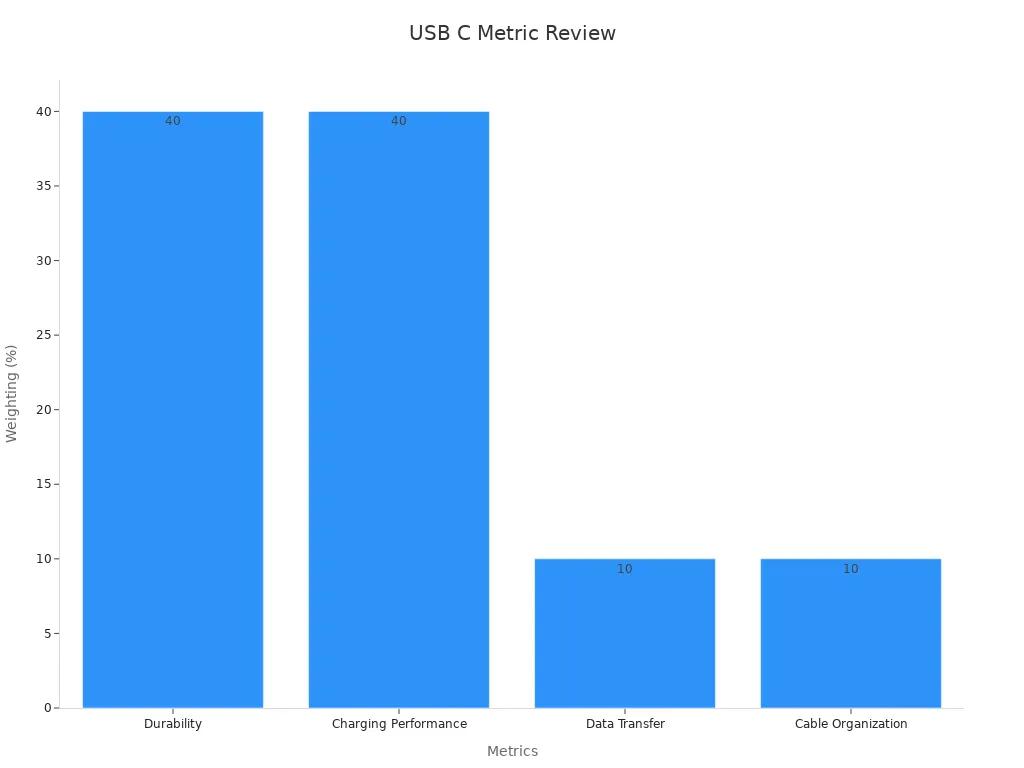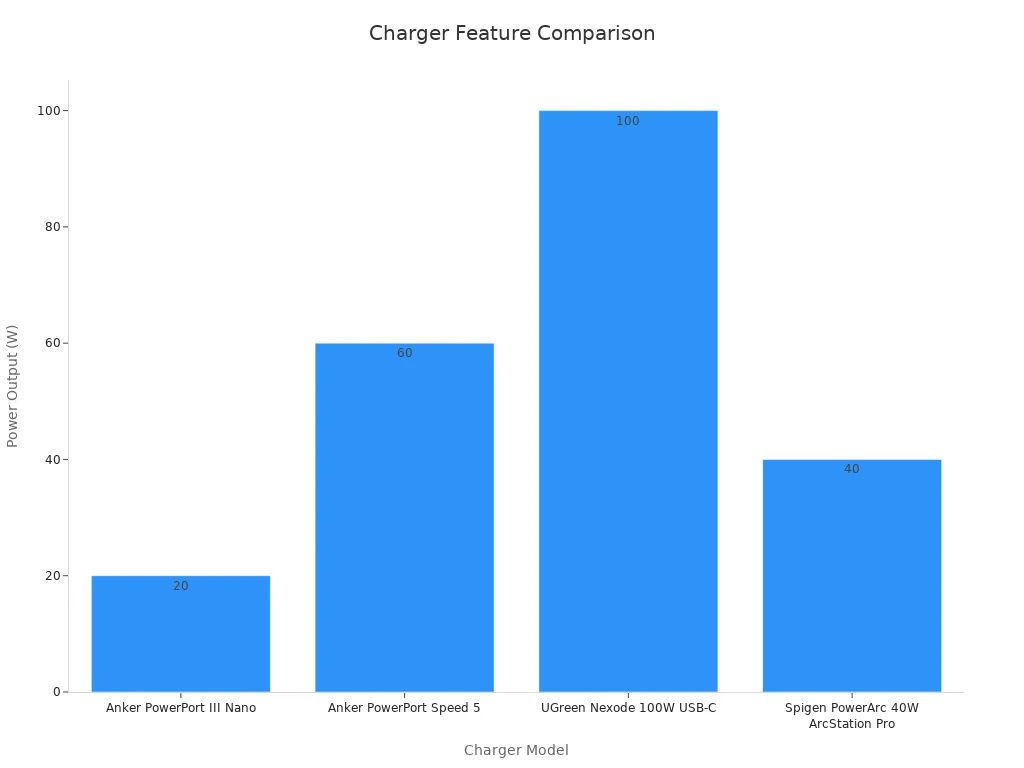USB-C chargers redefine how you charge your iPhone, making them an essential part of any Buyer’s Guide for tech accessories. They deliver faster charging speeds compared to older options. For example:
– A USB-C charger reaches full power in 1 hour and 55 minutes.
– Lightning connectors charge up to 50% in just 30 minutes.
– Traditional 5W chargers take over 3 hours to fully charge your device.
This efficiency saves you time and keeps your device ready whenever you need it. With a USB-C port and cable, you get versatility for syncing data and powering other devices. Choosing the right USB-C power adapter is crucial, ensuring safety, durability, and value for your money. Avoid counterfeit chargers to protect your iPhone’s battery and performance, which is a key point in any comprehensive Buyer’s Guide.
Understanding USB C Chargers
What Makes USB-C Chargers Unique?
USB-C chargers stand out due to their advanced technology and versatility. Unlike older USB types, USB-C offers faster data transfer speeds, higher power delivery, and broader compatibility. Here’s a quick comparison:
| Feature | USB-C | Older USB Types |
|---|---|---|
| Speed | Up to 40Gbps (USB4) | Up to 480Mbps (USB 2.0) |
| Power Delivery | Up to 240W | Up to 2.5W (USB 2.0) |
| Versatility | Supports video/audio, PCIe | Limited applications |
USB-C chargers also use intelligent communication between the charger and the device. They exchange information about voltage and current requirements, ensuring optimal charging performance. This feature makes USB-C chargers more efficient and safer for your iPhone 15 and other devices.
Benefits of USB-C Chargers for iPhones
Switching to USB-C chargers offers several advantages for iPhone users. A 20-watt USB-C charger can charge an iPhone 12 battery from 0% to 50% in just 24 minutes, compared to 63 minutes with a 5-watt charger. This means you spend less time waiting and more time using your device. USB-C Power Delivery technology also supports faster charging speeds, up to 160% faster than traditional chargers.
Additionally, USB-C cables are more durable and versatile. You can use the same cable to charge your iPhone, sync data, or even connect to other devices like laptops. This reduces clutter and simplifies your tech setup.
Tip: Always choose high-quality USB-C cables to ensure safety and longevity for your iPhone.
Why USB-C is the Future for iPhone Charging
The shift towards USB-C technology is driven by global trends and consumer demand. Governments are pushing for standardized charging ports to reduce electronic waste. For example, the European Parliament has mandated USB-C ports for mobile devices by 2024. This move promotes universal charging solutions, making USB-C the preferred standard for iPhones.
Consumers also want faster charging times and more durable cables. USB-C technology meets these needs with its ability to handle higher wattages and deliver up to 240W of power. As more third-party manufacturers adopt USB-C, you’ll find a growing range of eco-friendly and high-performance options. This trend solidifies USB-C as the future of iPhone charging.
Key Factors to Consider
Compatibility with iPhone Models
When choosing a USB-C charger, you must ensure it is compatible with your iPhone model. Not all chargers work seamlessly with every device. For example, the iPhone 15 series now uses USB-C ports, while older models rely on Lightning connectors. This shift highlights the importance of understanding your device’s charging port before purchasing a charger or cable.
Tip: Check your iPhone’s specifications to confirm its compatibility with USB-C chargers. This ensures optimal performance and avoids potential damage to your device.
Wattage and Fast Charging Capabilities
The wattage of a USB-C charger directly impacts its charging speed. Higher wattage chargers can charge devices faster, but they only deliver the maximum power your iPhone can handle. For instance, a 20W USB-C charger can charge an iPhone 12 battery from 0% to 50% in just 24 minutes. However, using a 100W charger won’t harm your device as long as it comes from a reputable brand.
Here’s a comparison of popular USB-C chargers and their performance:
| Charger Model | Total Output | Max Output (Top Port) | Ports Available | Charging Time (MacBook Pro) | Charging Time (iPad Pro) | Charging Time (iPhone 15 Pro Max) |
|---|---|---|---|---|---|---|
| Satechi 200W GaN 6-port | 200W | 100W | 6 | 80 minutes | 100 minutes | 94% in 70 minutes |
| Belkin BoostCharge Pro 140W | 140W | 140W | 3 + 1 USB-A | 84 minutes | 95 minutes | 93% in 70 minutes |
| Mophie SpeedPort 120 | 120W | 100W | 3 + 1 USB-A | 80 minutes | 110 minutes | 91% in 70 minutes |
Note: USB-C fast charging is only effective if your iPhone supports USB-C power delivery. Always verify your device’s specifications.
Importance of MFi Certification
MFi (Made for iPhone) certification guarantees that a USB-C charger or cable meets Apple’s safety and performance standards. Apple conducts extensive testing on certified products to ensure they are compatible with iPhones and other Apple devices. This certification minimizes risks like overheating, short circuits, or damage to your phone’s battery.
Using non-certified chargers may save money initially, but they can harm your device in the long run. MFi-certified products not only ensure safety but also enhance performance, making them a reliable choice for your iPhone.
Durability and Build Quality
Durability is a critical factor when selecting a USB-C charger or cable. Daily use can lead to wear and tear, especially if the materials are subpar. High-quality chargers often feature robust materials and thoughtful designs that prevent issues like cable fraying or connector damage.
- Look for chargers with reinforced connectors and braided cables for added durability.
- Long-lasting chargers reduce electronic waste, supporting sustainability.
- Warranty and customer support are also indicators of a product’s reliability.
Investing in a durable USB-C charger ensures it withstands daily use and provides consistent performance over time.
Balancing Price and Value
Price is often a deciding factor when buying a USB-C charger, but it’s essential to balance cost with value. Cheaper chargers may lack certifications or durability, while premium options often offer better performance and safety features.
Here’s a quick comparison of price points and value propositions:
| Model | Performance Metrics | Price Point | Value Proposition |
|---|---|---|---|
| Tollefe 5-in-1 | Exceptional | Approachable | Strong value with wide device support |
| Spigen SteadiBoost | Similar performance | Slightly less | Exceptional value for a two-port charger |
Tip: Avoid chargers with suspiciously low prices. They often compromise on quality and safety, which can damage your iPhone or pose safety risks.
How to Identify High-Quality USB C Chargers
Recognizing MFi-Certified Products
MFi (Made for iPhone) certification is a hallmark of quality and safety for USB-C chargers and cables. Apple awards this certification to products that meet its stringent standards. When you choose an MFi-certified charger, you ensure compatibility with your iPhone and reduce risks like overheating or battery damage.
Apple uses a rigorous verification process to certify products. Here’s a breakdown of what goes into MFi certification:
| Verification Process | Description |
|---|---|
| Quality Testing | Accessories undergo stringent tests to meet Apple’s standards for quality, safety, and performance. |
| Compatibility Checks | Ensures that the accessory works seamlessly with Apple devices. |
| Safety Certifications | Compliance with essential safety certifications such as UL, FCC, CE, etc. |
| Compliance Testing | Manufacturers must run products through Apple compliance and safety tests to gain MFi certification. |
| Quality Assurance | Strict conditions and spot checks by Apple ensure product quality and avoid malfunctions. |
MFi-certified products offer several benefits. They guarantee safety, prevent malfunctions, and ensure optimal performance. For example:
| Benefit | Description |
|---|---|
| Product Safety | MFi certification guarantees product safety and specification under normal usage. |
| Malfunction Prevention | Avoids issues like data transfer failure and battery explosions. |
Tip: Look for the MFi logo on the packaging or product description when buying USB-C chargers or charging cables. This ensures you’re getting a reliable product.
Choosing Reputable Brands
Reputable brands consistently deliver high-quality USB-C chargers and cables. These brands invest in research, testing, and innovation to ensure their products meet safety and performance standards. Choosing a trusted brand reduces the risk of buying subpar or unsafe chargers.
Market analysis and performance reviews highlight the importance of selecting reputable brands. For instance:
– Hands-on testing with 30 USB-C cables and adapters revealed significant differences in speed and durability.
– Advanced equipment measured charging rates and signal integrity, ensuring reliability.
Here’s how reputable brands perform across key metrics:
| Metric | Weighting | Description |
|---|---|---|
| Durability | 40% | Evaluated by flexing cables over 100 times to check for damage and wear. |
| Charging Performance | 40% | Measured charging rates using USB multimeters to assess how quickly each cable charges devices. |
| Data Transfer | 10% | Timed how fast each cable could transfer large files to evaluate efficiency. |
| Cable Organization | 10% | Rated how easy it is to keep each cable organized, considering factors like tangling and storage. |
Note: Brands like Anker, Belkin, and Spigen consistently rank high in reviews for their durability, charging performance, and safety features.
Avoiding Suspiciously Low Prices
While it’s tempting to save money, extremely low-priced USB-C chargers often come with hidden risks. These products may lack essential safety features, leading to overheating, short circuits, or even damage to your iPhone. Counterfeit chargers also fail to meet Apple’s standards, which can result in poor performance or device malfunctions.
Here’s why you should avoid suspiciously cheap chargers:
– They often use substandard materials that wear out quickly.
– They lack certifications like MFi, UL, or FCC, increasing safety risks.
– They may not support fast charging or data transfer, limiting their functionality.
Tip: If a USB-C to USB-A adapter or charger seems too good to be true, it probably is. Stick to products from reputable brands with verified certifications.
Checking Customer Reviews and Ratings
Customer reviews and ratings provide valuable insights into the quality and performance of USB-C chargers. Before making a purchase, check what other users say about the product. Look for reviews that mention durability, charging speed, and compatibility with iPhones.
When analyzing reviews, focus on these aspects:
– Durability: Does the charger or cable hold up well over time?
– Charging Performance: Does it deliver fast and efficient charging?
– Compatibility: Does it work seamlessly with your iPhone model?
Reviews often highlight real-world experiences, helping you make an informed decision. For example, many users praise Anker chargers for their reliability and fast charging capabilities. Similarly, Belkin products receive high ratings for their build quality and safety features.
Pro Tip: Avoid products with overwhelmingly negative reviews or those with no reviews at all. A lack of feedback could indicate a new or unreliable product.
Buyer’s Guide to Top USB C iPhone Chargers
Best Overall USB-C Charger
When searching for the best overall USB-C charger, you need a product that excels in speed, versatility, and reliability. The Anker PowerExpand Elite stands out due to its exceptional performance across multiple metrics. It supports peak data transfer speeds of up to 20Gbps and Thunderbolt speeds of up to 40Gbps. This charger also offers video output capabilities for 8K and multiple 4K displays, making it ideal for both charging and data transfer.
| Feature | Specification |
|---|---|
| Peak Data Transfer Speed | Up to 20Gbps (USB4) |
| Thunderbolt Speed | Up to 40Gbps |
| USB4 Speed | 10Gbps or 20Gbps |
| Video Output Capability | Supports 8K and multiple 4K displays |
This charger’s versatility makes it a top choice for iPhone users who want a reliable adapter for both charging and syncing data. Its robust build ensures durability, while its compatibility with multiple devices adds value to your purchase.
Best Budget-Friendly USB-C Charger
If affordability is your priority, the Anker PowerPort III Nano offers excellent value without compromising on quality. This compact adapter delivers 20W of power, making it perfect for fast charging your iPhone. Despite its small size, it provides universal compatibility and high ease of use.
| Charger Model | Power Output | Compatibility | Ease of Use | Size and Weight |
|---|---|---|---|---|
| Anker PowerPort III Nano | 20W | Universal | High | Compact |
| Anker PowerPort Speed 5 | 60W | Universal | High | Moderate |
| UGreen Nexode 100W USB-C | 100W | Universal | High | Moderate |
| Spigen PowerArc 40W ArcStation Pro | 40W | Universal | High | Compact |
The PowerPort III Nano is an excellent choice for those who want a reliable charger at an approachable price point. Its compact design makes it easy to carry, whether you’re at home or on the go.
Best USB-C Charger for Travel
Traveling requires a charger that is lightweight, compact, and versatile. The Spigen PowerArc ArcStation Pro fits the bill perfectly. This adapter delivers 40W of power and supports universal compatibility, making it ideal for charging your iPhone and other devices. Its compact design ensures it fits easily into your bag or pocket.
This charger’s portability doesn’t compromise its performance. It charges your iPhone quickly while maintaining safety standards. Whether you’re traveling for work or leisure, the PowerArc ArcStation Pro ensures your devices stay powered up without adding bulk to your luggage.
Best High-Wattage USB-C Charger for Fast Charging
For those who prioritize speed, the Razer 130W GaN Charger is the ultimate choice. Its compact design and strong power output make it a standout option for fast charging. Testing revealed that while its max output is higher than competitors, its charging speeds remain consistent across devices like the MacBook Pro and iPhone.
- Compact design ensures portability.
- Strong power output supports fast charging for multiple devices.
- Testing methodology involved draining devices to 10% battery and recording charge added every 10 minutes.
This charger is perfect for users who need high wattage for fast charging without sacrificing portability. Its reliable performance ensures your iPhone charges efficiently, even during demanding use cases.
USB-C chargers provide faster charging and better efficiency for your iPhone. To make a safe choice, focus on compatibility, certifications, and durability.
- Choose MFi-certified chargers to protect your device.
- Avoid counterfeit products by sticking to trusted brands.
Tip: An informed purchase ensures your iPhone stays safe and performs at its best.
FAQ
What is the difference between USB-C and Lightning chargers?
USB-C chargers offer faster charging, higher power delivery, and universal compatibility. Lightning chargers, exclusive to Apple, provide slower charging and limited compatibility with non-Apple devices.
Can I use a USB-C charger with older iPhone models?
No, older iPhones with Lightning ports require a Lightning cable. However, you can use a USB-C to Lightning cable with a USB-C power adapter for faster charging.
How do I know if a USB-C charger is safe for my iPhone?
Look for MFi certification and reputable brands. Avoid chargers with no certifications or suspiciously low prices to protect your iPhone from damage.
Tip: Always check the product description for compatibility and safety certifications before purchasing.

